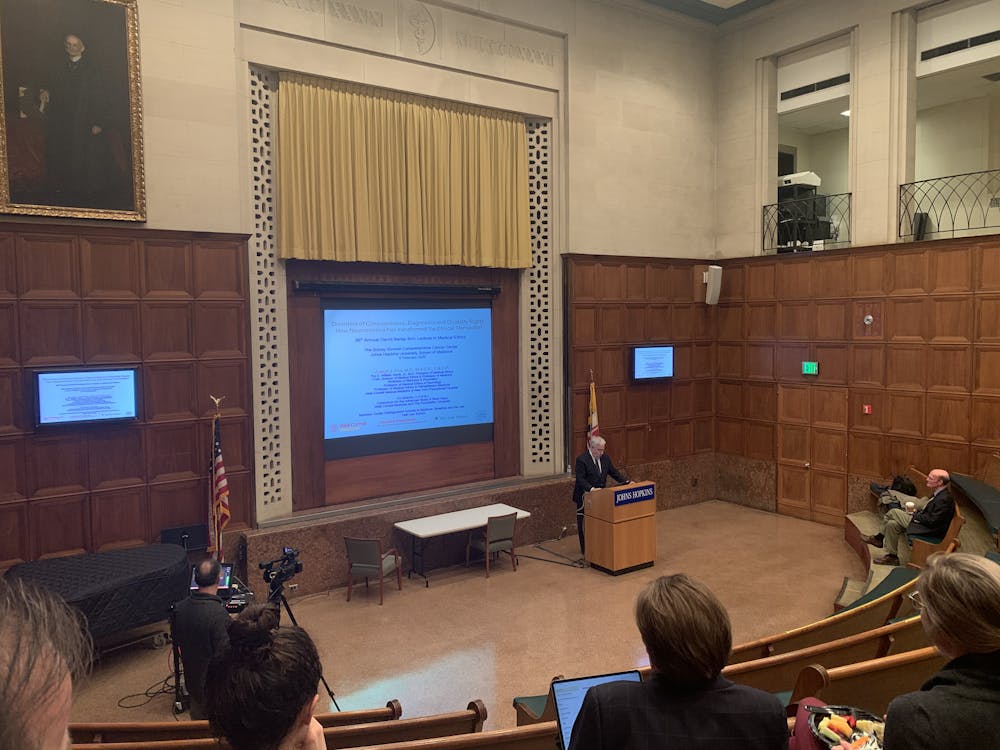Dr. Joseph J. Fins delivered the 38th David Barap Brin Lecture in Medical Ethics at the Hopkins Hospital on Thursday, Feb. 6. The subject of the talk was “Disorders of Consciousness, Diagnostics and Disability Rights: How Neuroscience Has Transformed the Clinical Transaction.”
Fins is a Professor of Medical Ethics and Chief of the Division of Medical Ethics at Weill Cornell Medical College, where his focus lies in the ethical and policy issues involved in brain injury and disorders of consciousness, especially the rights of individuals with severe brain injuries.
An injury of particular importance to Fins is the vegetative state, which has long been linked to the right to die. This idea was first broadcast on a national scale with the case of Karen Ann Quinlan. Quinlan was a 21-year-old girl who fell into a persistent vegetative state. Her parents insisted that prolonging her life was futile and requested that her ventilator be removed.
The court eventually ruled in favour of her parents. Despite removal from her ventilator, Quinlan continued to live another nine years. Fins was first introduced to medical ethics through that case. In fact, the neurologist consultant for the case, Dr. Fred Plum, was Fins’ mentor during his medical training at Cornell.
“At the time, it was believed nothing could or should be done. The results were immutable,” Fins said.
This sentiment has followed vegetative patients for decades now. Recent national studies have identified the mortality of patients with traumatic brain injury at 33 percent, however, 70 percent of these deaths were caused by decisions to withdraw their drug care.
Vegetative patients have also been reported as receiving abuse from their caregivers. In just the past year, a vegetative patient at a care centre in Phoenix, Arizona, gave birth following instances of sexual assault during her stay.
Fins described his work as “studying the scientific basis of tomorrow’s medical ethics.” This is perhaps exemplified by his involvement in a landmark paper published in the New England Journal of Medicine that found signs of cognition in brain-imaging tests in vegetative patients who were considered unresponsive and unaware of their surroundings.
The implications of this paper changed the vocabulary surrounding vegetative patients. Permanent vegetative patients have now become persistent vegetative patients, a term which recognizes the incredible ability of the human brain to heal severe trauma, even decades after injury.
Fins has seen this incredible healing process in a patient named Terry Wallis. Wallis fell into a vegetative state following an automobile accident in 1984. Nineteen years later, in 2003, he awakened from his minimally conscious state and began to talk.
Fins worked with Wallis in two studies using diffusion tensor imaging after he regained consciousness, conducted 18 months apart. The imaging results showed dramatic reorganization of his brain tissue around trauma in the parietal lobe, especially in his cerebellum, where new neural fibers were visible.
“This was the first time the process of sprouting and pruning was seen in a patient with brain trauma, two decades after injury. After this long period of latency, something sparked new development of his brain,” Fins said. “In this way, the recovering brain is very similar to the developing brain.”
Wallis’ recovery wasn’t simply a biological breakthrough: It also represented a shift in the perception of patients in the vegetative state.
“There has been a kind of nihilism towards these patients. This represents a cultural shift,” Fins said.
But the question remains: How can doctors know whether a patient is in a non-vegetative state, often called a minimally conscious state?
“The use of a simple electroencephalogram (EEG) could fundamentally change how we practice medicine in the Intensive Care Unit,” Fins said.
This was shown in a study conducted at Columbia University and published in the New England Journal of Medicine which found that 15 percent of the vegetative patients had brain activation detected by the EEG.
“There are countless people who are sequestered to a life of isolation, when in fact they are sound and conscious individuals,” Fins said.
Fins questioned why outrage against treatment of vegetative patients is not more widespread, but noted that, at the same time, he is not surprised.
“From Seneca Falls to Selma to Stonewall, the dispossessed had to suffer to gain their rights,” he said.
When Fins talks to college students about inequalities of the past, he is often met with smug comments. However, he noted that he sees parallels with the way vegetative patients are treated today.
“The next generation will look at you and ask how you could let conscious people sit isolated in nursing homes,” he said.





